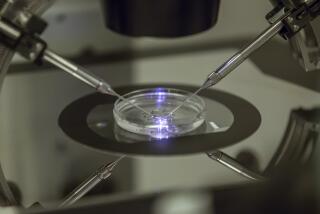But Basic Design Was Not at Fault, Foreman Says : Jury Awards Woman $35,000 in Suit Alleging IUD Defect
- Share via
A Costa Mesa woman who blamed an intrauterine birth-control device for an infection in her uterus and a hysterectomy won a jury award Friday of $35,000, an amount that disappointed her despite the satisfaction of winning her suit.
The verdict on behalf of Joan Goldsmith represents the first successful suit against Ortho Pharmaceutical Corp. of New Jersey involving its intrauterine device (IUD) known as Lippes loop, said lawyers on both sides.
But the jurors did not intend to send any message to the public about a general design defect in the IUD, jury foreman George M. Fairchild of Placentia indicated after the verdict.
The String Broke
“The loop had nothing to do with her hysterectomy or her (infection), but we felt she had to have a (dilatation and curettage operation) because the string broke when doctors tried to get it out,” Fairchild said.
Goldsmith and her attorney, Marylyne Goldstock of Newport Beach, had sought more than $250,000 in compensatory and punitive damages on theories that Ortho’s product was defectively designed, that Ortho failed to give adequate warnings about risks of the IUD and that Ortho failed to remove the product after a newer model was introduced in 1968.
But Fairchild said it was only the IUD Goldsmith had that was defective, and the defect was in the string, not the overall design.
“I’m disappointed at the amount, but I’m happy we got the verdict,” said Goldsmith, 38.
She acknowledged being disappointed mainly because about $14,000 will go toward medical bills and a like amount toward attorney fees, leaving her with some $7,000 in compensation for her pain and loss.
Probably Won’t Appeal
Defense attorney Scott E. Wood of Los Angeles said Ortho, a subsidiary of Johnson & Johnson, probably would not appeal.
When Goldsmith received the older IUD in 1972, the newer one was on the market. It was redesigned, Wood claimed, so it could be sold in pre-sterilized packages. Goldstock argued that it was redesigned to lessen the risk of perforation of the uterine wall.
Goldsmith, now a divorced mother of an 18-year-old daughter, contracted pelvic inflammatory disease, an infection that led to tubo-ovarian abscesses in February, 1981. Doctors tried to remove the IUD to see if the device may have been causing the infection or preventing its cure, but the string broke.
The disease, though, had become so serious that doctors decided to remove her uterus, Fallopian tubes and ovaries.
Goldstock called the Lippes loop a “time bomb” because about 6 million of the IUDs have been sold since the product went on the market in the mid-1960s. Wood said two million to three million women have the older model and have had few problems with it.
The older model is now sold only to the United States government for use in foreign aid programs, Wood said.
More to Read
Inside the business of entertainment
The Wide Shot brings you news, analysis and insights on everything from streaming wars to production — and what it all means for the future.
You may occasionally receive promotional content from the Los Angeles Times.










